In the age of the unprecedented worldwide pandemic, we were forced to rethink all the things we took for granted. Our values and our priorities, our leisure time, and most importantly, the way we work.
No wonder that the classic 8-hour workday MO, which was once a socialist dream, today seems redundant, to say the least. With more and more people switching to remote work, people are now realizing the 8-hour may have been a counterproductive lie.
So the TikToker AutisticCommProf, @ndcommlion, has recently made an illuminating video explaining how the “8 hours for work, 8 hours for rest, 8 hours for what you will” slogan from the late 1800s labor movement is a false promise.
When put into our everyday practice, it destroys our work-life balance, leaving us exhausted and unproductive. Let’s see her whole point right below, and share what you think in the comment section!
This woman has recently shared an illuminating TikTok video on why the standard 8-hour work/sleep/play model is outdated and no longer works in our modern society

Image credits: ndcommlion
In a video, she referred to this tweet from the Twitter user Jarrel, confirming that this in fact is very true
Image credits: slimrel__
@ndcommlion#greenscreen #capitalismsucks #capitalism #worklife #worklifebalance #fightfor15 #eattherich #generalstrikeoct15 #generalstrike♬ original sound – AutisticCommProf
Image credits: ndcommlion
The 8-hour-long workday is one of the enduring legacies of the First Industrial Revolution. With the advent of manufacturing firms and industries that required hard labor, productivity was usually measured in linear terms. The workers worked for 8 hours a day producing the units of output that got calculated.
This was also a much better solution than the standard 12- or 14-hour days factory workers, including children, had worked before. Over the next 100 years, labor unions of various industries in the US adopted the eight-hour standard. Moreover, Henry Ford brought the idea further into the mainstream in 1926 by mandating a five-day, 40-hour workweek in his company’s factories. In 1940, Congress officially set the American workweek at 40 hours. The same work week we have today, in 2021.
Image credits: ndcommlion
No wonder the 8-hour workday received a huge backlash during the pandemic, which, over the past year, has forced millions of office workers to set up shop from home. The call for shorter hours followed with people pointing to the fact that the 8-hour-long workday is not only unproductive, but it destroys work-life balance and sucks up all the remaining energy meant for leisure activities and resting.
A growing body of research indicates that five hours is about the maximum that most of us can concentrate hard on something. The productivity consultant Alex Pang believes that “there are periods when you can push past that, but the reality is that most of us have about that [amount of] good work time in us every day.”
It turns out, the current 8-8-8 structure comes from the labor movement in the early 19th ct. which aimed at improving work and life balance at the time
Image credits: Wikimedia.Common
Bored Panda reached out to David Andrew Wiebe, a best-selling author, entrepreneur and musician who shared some very interesting insights on the 8-hour workday standard and why it is redundant. “Apparently it has its origins in 16th-century Spain, but like most things that have become routine or habit, the eight-hour workday has been perpetuated through the education system. And, the modern education system was mostly formed around producing factory workers,” David said.
“On average, workers are only productive for about three hours a day,” he said and added that “There may be reasons for this beyond obvious human limitations, such as unnecessary distractions in the workplace, but studies also show top-performing executives and entrepreneurs didn’t fare much better (they may be able to squeeze another 25 to 30 minutes of productive time out of their day!).”
The new model seemed like a much better structure than the 12- or 14-hour days factory workers, including children, were expected to put in at the time
Image credits: jonesfamilyhistory
Moreover, “The idea that ‘sitting is the new smoking’ is also prevalent, suggesting that staying sedentary for long hours diminishes our willpower, energy, and ability to focus. Again, those who have standing desks don’t fare much better, because they still aren’t getting the movement their body needs. If you have a physical labor job, that’s a different story.”
David also pointed out that obesity is a growing problem, and it has a lot more to do with food consumption, which can be connected to stress levels. “When we’re tired, exhausted, or even frustrated, we tend to reach for unhealthy food,” he said and added that higher levels of performance are possible, but sitting at a desk for longer hours is not the answer. “Breaking up the day with exercise and meditation can help in creating second winds,” David explained.
Image credits: politicstheoryphotography
Many have adapted to working from home and have discovered new routines for themselves. “For some, this has proved a blessing. For others, not so much,” he said and added that “the pandemic has fundamentally shifted the way we think about a lot of things. It’s only natural that we’d begin to re-examine areas of our lives that weren’t working before.”
Because of that, choice holds more significance than ever, David argues. “We can choose eight-hour workdays. We can choose four-hour workdays, And if we want, we can choose 12-hour workdays,” he explained and added that although part of this choice should be informed by performance, another important factor is what you want out of life. “And depending on aspirations or ambitions, we might choose to create something outside of our day jobs, requiring more of our time and energy,” David concluded.
And people had a lot of thoughts to share in response to the 9-5 workday debate
And there have been studies proving that people work more efficiently with shorter days + less days per week!
Shorter days should be a thing or at least a 4 day work week instead of a 5. Everyone is burnt out. Plus, not like you are playing when you get home. You are cooking, cleaning, helping kids with homework, running around town trying to grab this or that, taking this kid to that thing. Best thing about the pandemic was I was working from home for a hot second and man I felt great, felt like I had so much more time and I could do laundry on my lunch break. It was amazing. Plus, no dressing up for the office, no makeup, no hair, just roll out of bed, drink some coffee and log in. Really made it clear to me that my next position will be a remote position.
I think the average single parent, or the typical working mother, puts in more than 8 hours of work at home every day.
That's an important factor. Back in the day when this 8/8/8 argument was put into place, the average household had a "stay at home mother", or other support for raising the kids and keeping the home. Nowadays most households need to have both parents work just to stay on top of the bills. So it is 8 hours work, plus the commute time, and your lunch break etc... 8 hours sleep, and the rest of the time is cooking cleaning, and taking care of the family. Very little time for "what we will"
Load More Replies...I feel sorry for all those people that are living to work. I started to realize that I'm very privileged living in a society where work- life balance is so much better than in many other countries is even possible. I guess I'm living the American dream. In Europe.
Try a 12 hour shift from 7 am until 7pm I work as a pastoral care nurse 45 minute for lunch and 30 minutes break between 4 and 5 pm for 4 days on the trot by the time I get home it's nearly 8pm and I have to get up again at 5am to be out the door for 6.10am it's soul destroying and some times you do a 9.30am to 9.30
Are you planning on switching your career anytime soon?
Load More Replies...Also, the typical worker is generating much more wealth for its employer than our great grandfathers. The productivity has skyrocketed.
Actually throughout Asia most people work 10 hours a day, 6 days a week.
I had a job as a warehouse worker, with a temporary employment agency. The company we usually worked for, had too few orders, so we were "loaned" to another company. Even the way to the regular workplace took about 2 hours every day. The way to the new job, took 2 hours ... one way. A 9 hours shift, after driving 2 hours ... crammed together with 6 colleagues in a minivan ... and then 2 hours back. All in all, a working day of 13 hours ... and for an hourly wage of just 11 €. After 3 weeks working there, they extended the shift to 10 hours a day for at least 4 weeks, because they had to much work. Anyone who didn't agree to that, was "free to go" ... which I then did! I work to live ... I don't live to work!
People should be paid more for their work AND they should get shorter workdays. I'll say this before anybody comes at me about not being able to afford paying proper salaries to their workers: if you can't afford to pay your workers well, then you don't afford having a company with employees. Wealth needs to be redistributed all around the world, money is something that should circulate around, it's not something to be hoarded endlessly. We need to start taking mental and physical health issues into consideration, it's part of the process of making this world a better place for the majority of people.
with my job, I am on call for 12 hours straight. I can get called out at the beginning of my shift for an 11 hour run, or at the end of my shift for an 11 hour run. i drive a half hour each way to work, and they only have to give me an 8 hour rest between shifts. it sucks
I work 12 hour shifts on a rotating shift pattern (2 days and 3 nights, 2 days 2 nights and 3 days and 2 night shifts). Yes it's exhausting and yes it's tiring and you have no life whilst on shift but I do get 4 or 5 days off between these block of shifts which is awesome. I used to work mon to fri 9 - 5 and I was honestly more exhausted as there was only a 2 day break in between. This way I get more time to recover, do my housework and errands and enjoy family time. Plus if I want two weeks off I only need to book one week and I have 12 to 14 days off.
I kind of liked my previous model of 2 eight hour shifts and 2 twelve hour shifts. Three days weekend? That was amazing. But it be honest, I don't think that I really work more than ~5 hours per day. I can do everything I'm supposed to do in two 12 hours long shifts and one 6 hours. Sure, I will be exhausted on the last one, but then I would have four days for whatever I want.
This is not a new but still a very valid point that people need to move on from. Also the idea that everyone must work from morning to afternoon. We live in 2021. People, as far as its possible, should be able to work whenever it fits them best
now do that with children at home, by the time homework is done bath and bed you literally have no time to unwind.
8-8-8 only seems like a good deal compared to the insane schedules seen during the industrial revolution. But pre-1700’s, people actually worked less than we do today (including most peasants, farmers, and even hunter-gatherers) https://www.google.com/amp/s/www.lovemoney.com/galleries/amp/84600/how-many-hours-did-people-really-work-across-human-history
The whole idea of an 8-hour work day was predicated on the fact that people married at a much younger age, and the overwhelming majority of women didn't work and, thus, were the ones who did all the errands and chores.
I'm not sure where all this anti-work sentiment is coming from these days but everyone has to work so you can pay your rent, bills, food, utilities, etc.
It isn't anti-work, it's undoing the idea that "busyness" and working more than 40 hours a week is righteous, noble, and deserves to be lauded.
Load More Replies...I don't understand this issue at all. If you want to work less hours and have more time for yourself, just make your own business if it's that easy. Like how are you expecting to compete with rising economies. Pretty sure most of those 9-5 jobs some people hate so much will be outsourced overseas in a near future anyway.
"rising economies" are built on exhausted workers with poor mental health. They're not exactly role models. Also, the wages in developing countries are crap.
Load More Replies...And there have been studies proving that people work more efficiently with shorter days + less days per week!
Shorter days should be a thing or at least a 4 day work week instead of a 5. Everyone is burnt out. Plus, not like you are playing when you get home. You are cooking, cleaning, helping kids with homework, running around town trying to grab this or that, taking this kid to that thing. Best thing about the pandemic was I was working from home for a hot second and man I felt great, felt like I had so much more time and I could do laundry on my lunch break. It was amazing. Plus, no dressing up for the office, no makeup, no hair, just roll out of bed, drink some coffee and log in. Really made it clear to me that my next position will be a remote position.
I think the average single parent, or the typical working mother, puts in more than 8 hours of work at home every day.
That's an important factor. Back in the day when this 8/8/8 argument was put into place, the average household had a "stay at home mother", or other support for raising the kids and keeping the home. Nowadays most households need to have both parents work just to stay on top of the bills. So it is 8 hours work, plus the commute time, and your lunch break etc... 8 hours sleep, and the rest of the time is cooking cleaning, and taking care of the family. Very little time for "what we will"
Load More Replies...I feel sorry for all those people that are living to work. I started to realize that I'm very privileged living in a society where work- life balance is so much better than in many other countries is even possible. I guess I'm living the American dream. In Europe.
Try a 12 hour shift from 7 am until 7pm I work as a pastoral care nurse 45 minute for lunch and 30 minutes break between 4 and 5 pm for 4 days on the trot by the time I get home it's nearly 8pm and I have to get up again at 5am to be out the door for 6.10am it's soul destroying and some times you do a 9.30am to 9.30
Are you planning on switching your career anytime soon?
Load More Replies...Also, the typical worker is generating much more wealth for its employer than our great grandfathers. The productivity has skyrocketed.
Actually throughout Asia most people work 10 hours a day, 6 days a week.
I had a job as a warehouse worker, with a temporary employment agency. The company we usually worked for, had too few orders, so we were "loaned" to another company. Even the way to the regular workplace took about 2 hours every day. The way to the new job, took 2 hours ... one way. A 9 hours shift, after driving 2 hours ... crammed together with 6 colleagues in a minivan ... and then 2 hours back. All in all, a working day of 13 hours ... and for an hourly wage of just 11 €. After 3 weeks working there, they extended the shift to 10 hours a day for at least 4 weeks, because they had to much work. Anyone who didn't agree to that, was "free to go" ... which I then did! I work to live ... I don't live to work!
People should be paid more for their work AND they should get shorter workdays. I'll say this before anybody comes at me about not being able to afford paying proper salaries to their workers: if you can't afford to pay your workers well, then you don't afford having a company with employees. Wealth needs to be redistributed all around the world, money is something that should circulate around, it's not something to be hoarded endlessly. We need to start taking mental and physical health issues into consideration, it's part of the process of making this world a better place for the majority of people.
with my job, I am on call for 12 hours straight. I can get called out at the beginning of my shift for an 11 hour run, or at the end of my shift for an 11 hour run. i drive a half hour each way to work, and they only have to give me an 8 hour rest between shifts. it sucks
I work 12 hour shifts on a rotating shift pattern (2 days and 3 nights, 2 days 2 nights and 3 days and 2 night shifts). Yes it's exhausting and yes it's tiring and you have no life whilst on shift but I do get 4 or 5 days off between these block of shifts which is awesome. I used to work mon to fri 9 - 5 and I was honestly more exhausted as there was only a 2 day break in between. This way I get more time to recover, do my housework and errands and enjoy family time. Plus if I want two weeks off I only need to book one week and I have 12 to 14 days off.
I kind of liked my previous model of 2 eight hour shifts and 2 twelve hour shifts. Three days weekend? That was amazing. But it be honest, I don't think that I really work more than ~5 hours per day. I can do everything I'm supposed to do in two 12 hours long shifts and one 6 hours. Sure, I will be exhausted on the last one, but then I would have four days for whatever I want.
This is not a new but still a very valid point that people need to move on from. Also the idea that everyone must work from morning to afternoon. We live in 2021. People, as far as its possible, should be able to work whenever it fits them best
now do that with children at home, by the time homework is done bath and bed you literally have no time to unwind.
8-8-8 only seems like a good deal compared to the insane schedules seen during the industrial revolution. But pre-1700’s, people actually worked less than we do today (including most peasants, farmers, and even hunter-gatherers) https://www.google.com/amp/s/www.lovemoney.com/galleries/amp/84600/how-many-hours-did-people-really-work-across-human-history
The whole idea of an 8-hour work day was predicated on the fact that people married at a much younger age, and the overwhelming majority of women didn't work and, thus, were the ones who did all the errands and chores.
I'm not sure where all this anti-work sentiment is coming from these days but everyone has to work so you can pay your rent, bills, food, utilities, etc.
It isn't anti-work, it's undoing the idea that "busyness" and working more than 40 hours a week is righteous, noble, and deserves to be lauded.
Load More Replies...I don't understand this issue at all. If you want to work less hours and have more time for yourself, just make your own business if it's that easy. Like how are you expecting to compete with rising economies. Pretty sure most of those 9-5 jobs some people hate so much will be outsourced overseas in a near future anyway.
"rising economies" are built on exhausted workers with poor mental health. They're not exactly role models. Also, the wages in developing countries are crap.
Load More Replies...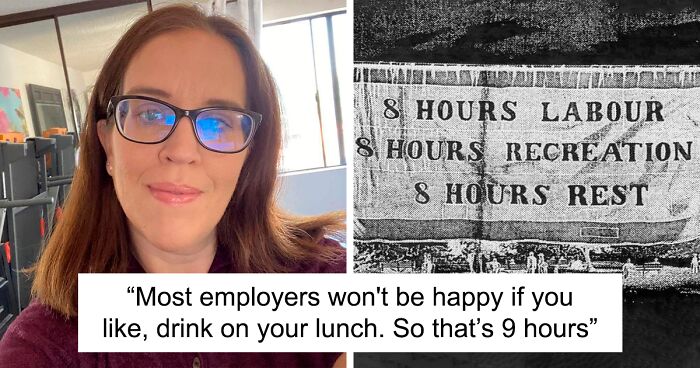
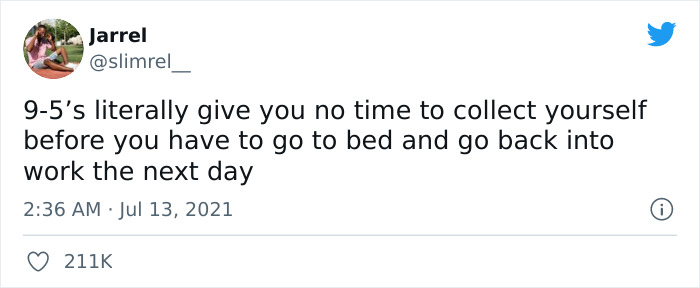
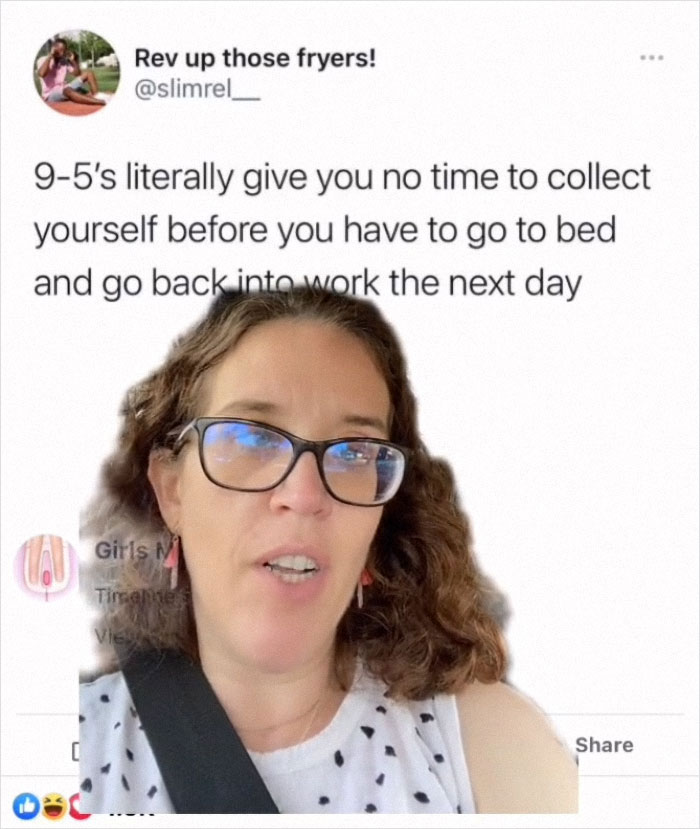
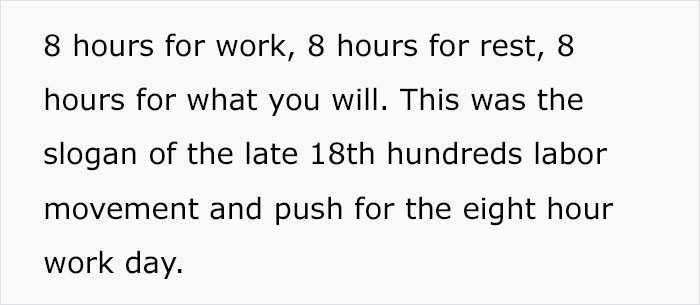
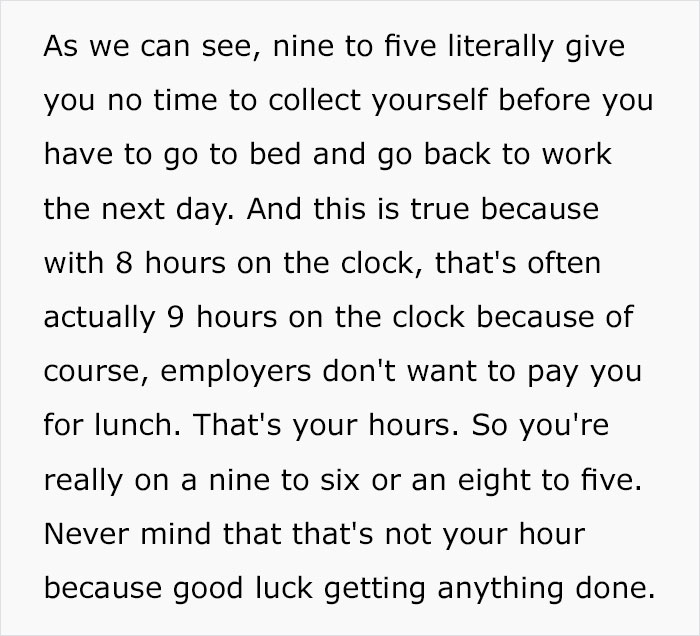

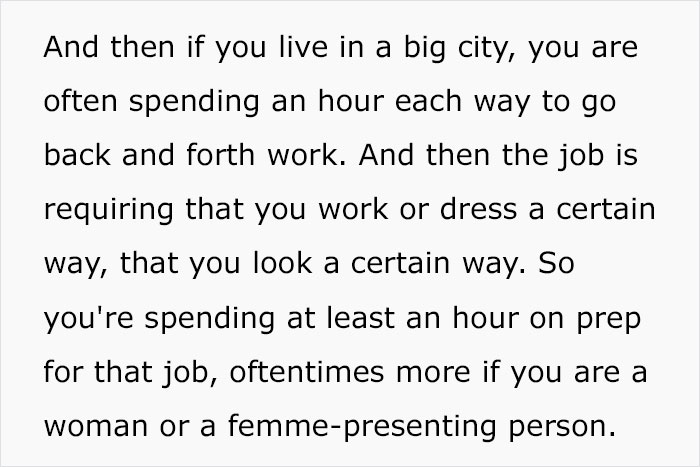
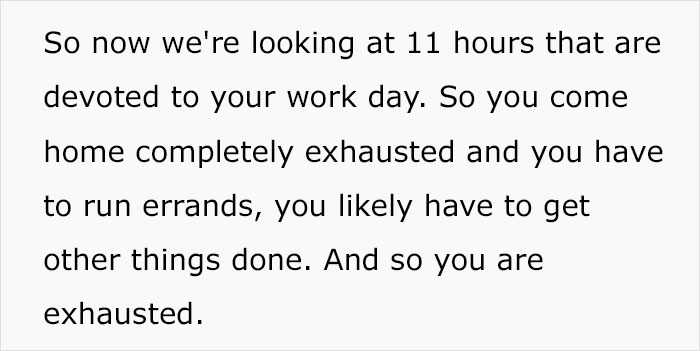
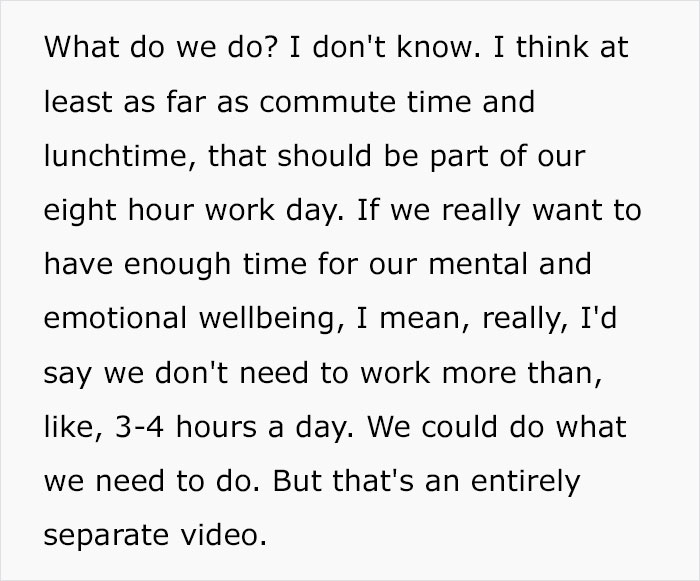
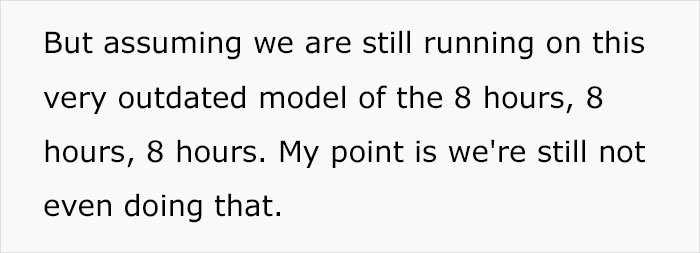
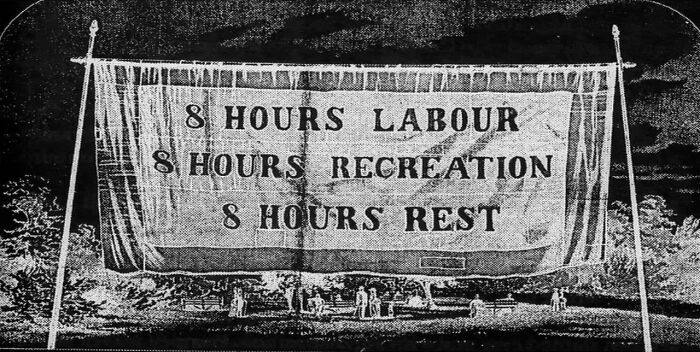
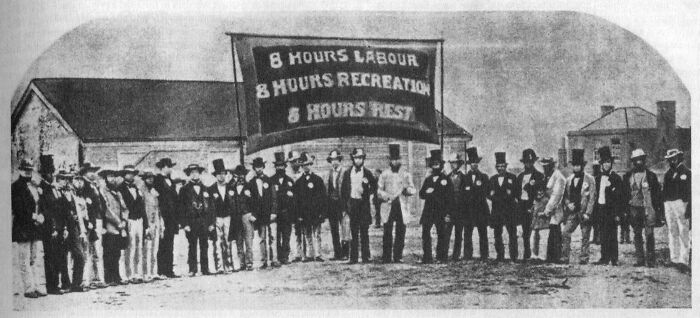
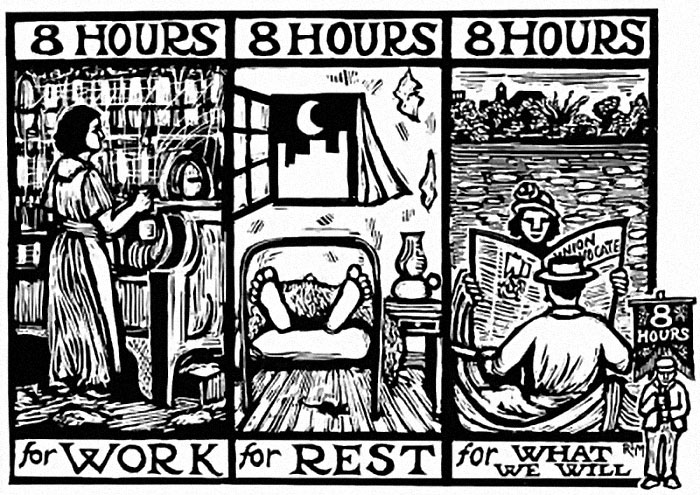
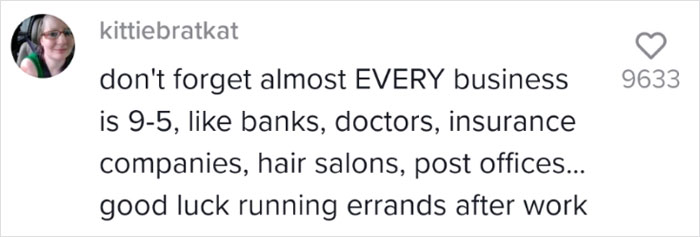
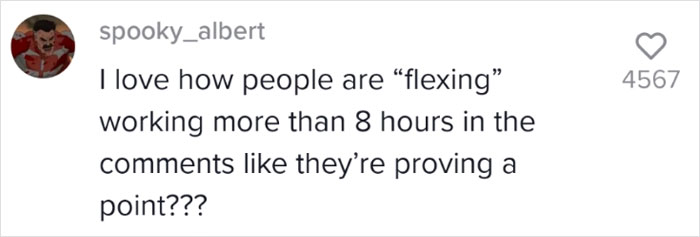




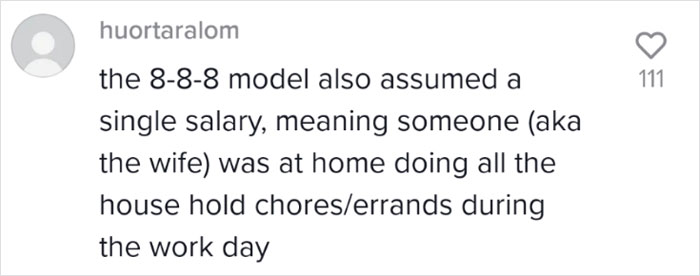
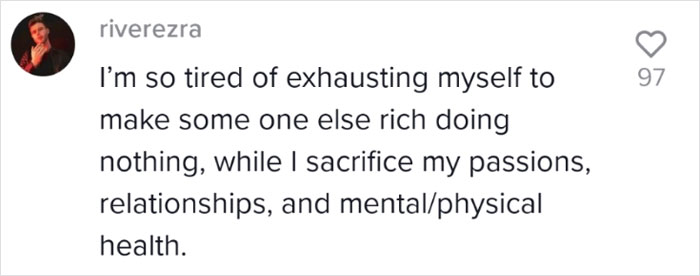
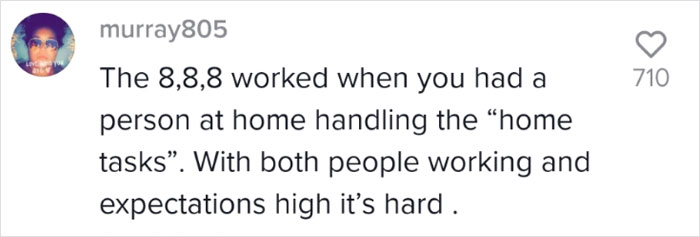

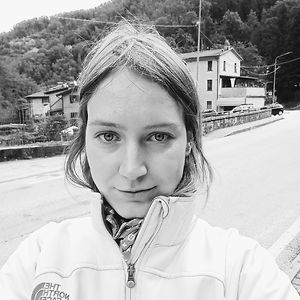



118
52